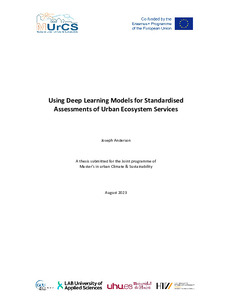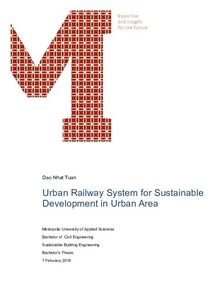Using Deep Learning Models for Standardised Assessments of Urban Ecosystem Services
Anderson, Joseph (2023)
Anderson, Joseph
2023
All rights reserved. This publication is copyrighted. You may download, display and print it for Your own personal use. Commercial use is prohibited.
Julkaisun pysyvä osoite on
https://urn.fi/URN:NBN:fi:amk-2023110929029
https://urn.fi/URN:NBN:fi:amk-2023110929029
Tiivistelmä
The benefits that humans receive from their environment, commonly classified as ecosystem services (ES), has a high demand in cities due to the increased population density. As the urban footprint escalates with human population growth, urban ecosystem services (UES) must be considered in urban planning and policymaking.
This study seeks to establish a replicable methodology for assessing UES across multiple cities, in order to establish standardised metrics and comparative analyses. Current research trends focus primarily on case studies that are contextualized to the given city, limiting the research’s applicability in cross-city comparisons or in developing state or federal policy (García-Pardo et al., 2022). The MAES 4th Report published by the EU JRC (Maes et al., 2016) was used as an international standard for categorizing UES and their associated service providing units. Furthermore, AI and deep learning models are investigated as a tool for efficient and accurate landcover assessments in the urban environment.
Applicationa and limitations of ES matrices are highlighted. An alternative approach to ES matrices is proposed, using the MAES 4th report UES providing units and the landcover classifications of the Esri “High Resolution Land Cover Classification – USA” deep learning model. This standardises “Traffic Light” UES matrix is then combined with the outputs of the deep learning model to estimate the relative presence of five regulating UES across ten US cities. Average accuracy per landcover type and per city were calculated, and F1 scores were used for statistical analysis.
The initial results of the study are promising, with the adjusted data achieving an average of 89% accuracy per city. In terms of landcover type accuracy, the average for the adjusted data was 88% with F1 scores ranging from .82-.94. calculations for average UES values for the ten cities were also calculated, with notable differences in values between temperate and arid cities.
Applications for the methodology are discussed, especially its usability for urban planners and as a standardised UES assessment for comparitive research. Limitations and areas of high error are discussed, including “Wetland” and “Barren” landcover classifications, edge effects in the outer extents of study areas, and limitations in current remote sensing capabilities.
Finally, future research possibilities are listed that could lead to improved accuracy and utility of the method. This study proposes a replicable remote-sensing based UES assessment methodology that is simple enough for cities with limited resources to replicate, and standardised enough that results can be compared across cities to broaden the comparative research within the field of UES.
This study seeks to establish a replicable methodology for assessing UES across multiple cities, in order to establish standardised metrics and comparative analyses. Current research trends focus primarily on case studies that are contextualized to the given city, limiting the research’s applicability in cross-city comparisons or in developing state or federal policy (García-Pardo et al., 2022). The MAES 4th Report published by the EU JRC (Maes et al., 2016) was used as an international standard for categorizing UES and their associated service providing units. Furthermore, AI and deep learning models are investigated as a tool for efficient and accurate landcover assessments in the urban environment.
Applicationa and limitations of ES matrices are highlighted. An alternative approach to ES matrices is proposed, using the MAES 4th report UES providing units and the landcover classifications of the Esri “High Resolution Land Cover Classification – USA” deep learning model. This standardises “Traffic Light” UES matrix is then combined with the outputs of the deep learning model to estimate the relative presence of five regulating UES across ten US cities. Average accuracy per landcover type and per city were calculated, and F1 scores were used for statistical analysis.
The initial results of the study are promising, with the adjusted data achieving an average of 89% accuracy per city. In terms of landcover type accuracy, the average for the adjusted data was 88% with F1 scores ranging from .82-.94. calculations for average UES values for the ten cities were also calculated, with notable differences in values between temperate and arid cities.
Applications for the methodology are discussed, especially its usability for urban planners and as a standardised UES assessment for comparitive research. Limitations and areas of high error are discussed, including “Wetland” and “Barren” landcover classifications, edge effects in the outer extents of study areas, and limitations in current remote sensing capabilities.
Finally, future research possibilities are listed that could lead to improved accuracy and utility of the method. This study proposes a replicable remote-sensing based UES assessment methodology that is simple enough for cities with limited resources to replicate, and standardised enough that results can be compared across cities to broaden the comparative research within the field of UES.
Kokoelmat
Samankaltainen aineisto
Näytetään aineisto, joilla on samankaltaisia nimekkeitä, tekijöitä tai asiasanoja.
-
Urban Railway System for Sustainable Development in Urban Area
Nhat Tuan, Dao (Metropolia Ammattikorkeakoulu, 2019)The aim of this thesis was to study an urban railway system for sustainable development of a metropolitan area. The thesis studied a basic type of municipal railway and its implementation by, first, studying two well-developed ... -
Mapping Thermal Hotspots in Malé, Maldives : Assessing the Relationship Between Urban Heat Islands, Climate, and Heat Risk for Sustainable Urban Planning
Hameed, Aminath Maiha (2023)This study aims to support climate-conscious urban development in greater Male’, Maldives, based on characterizations of the local microclimate. It explores intra-urban temperature variations, identifies heat risks and ... -
Assessing the Influence of Urban Form on the Cooling Impacts of Urban Parks : A Case Study in Glasgow
Lelei, Najma Yusuf (2023)Urban Heat Island (UHI) effect has been a growing concern in the UK; therefore, the mitigation of such effects would contribute to sustainable urban development. A review of literature indicates that green infrastructure ...



